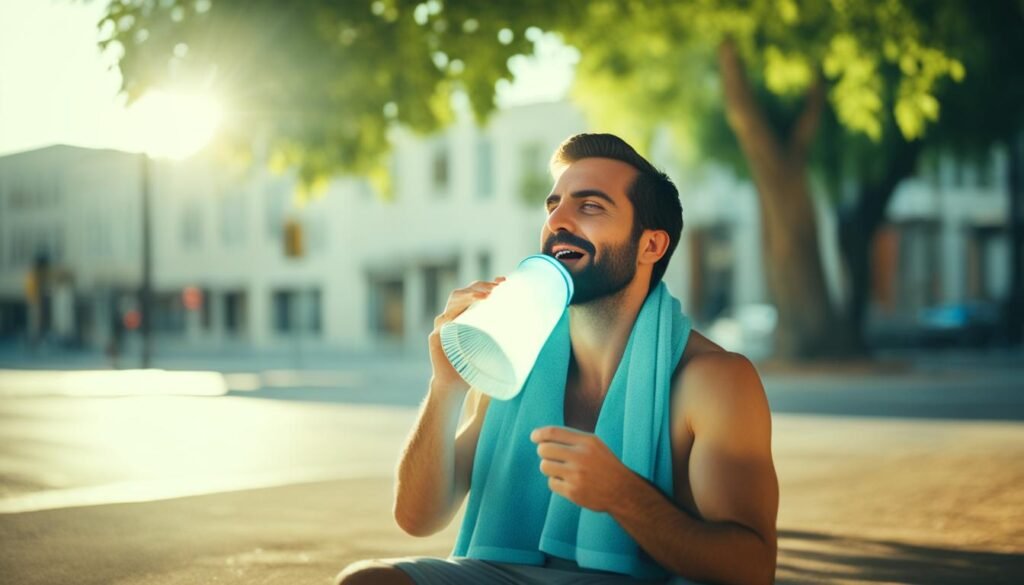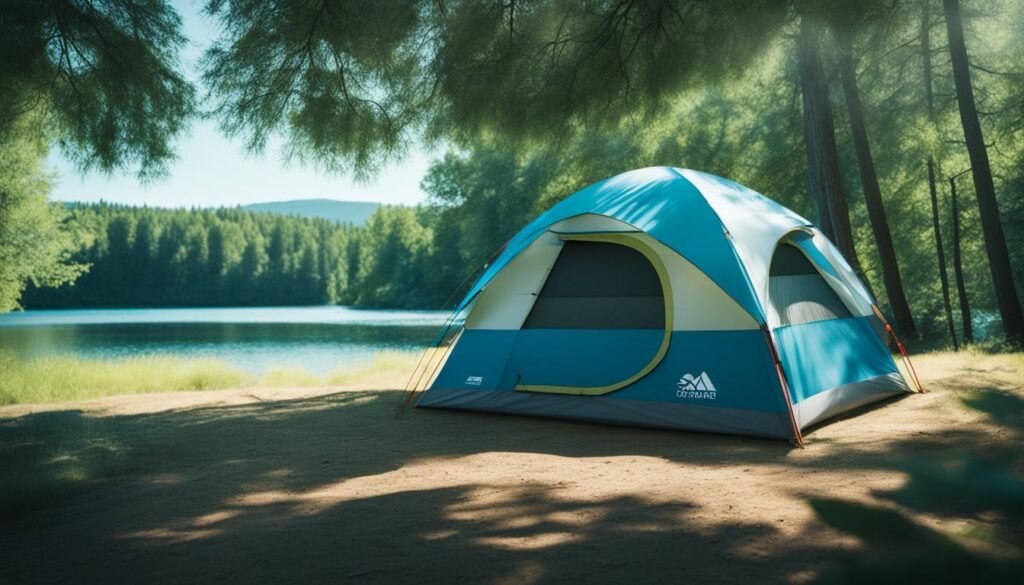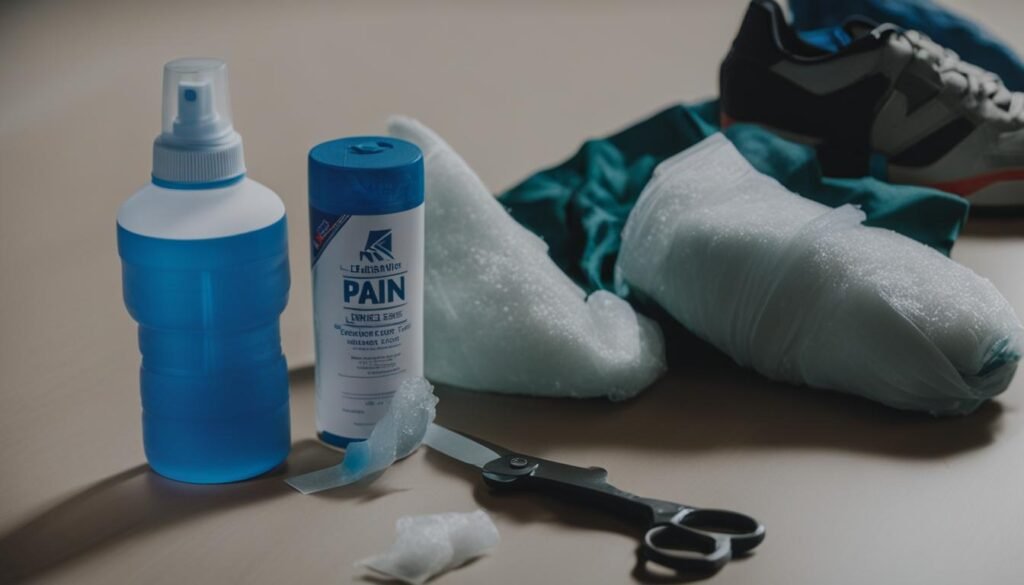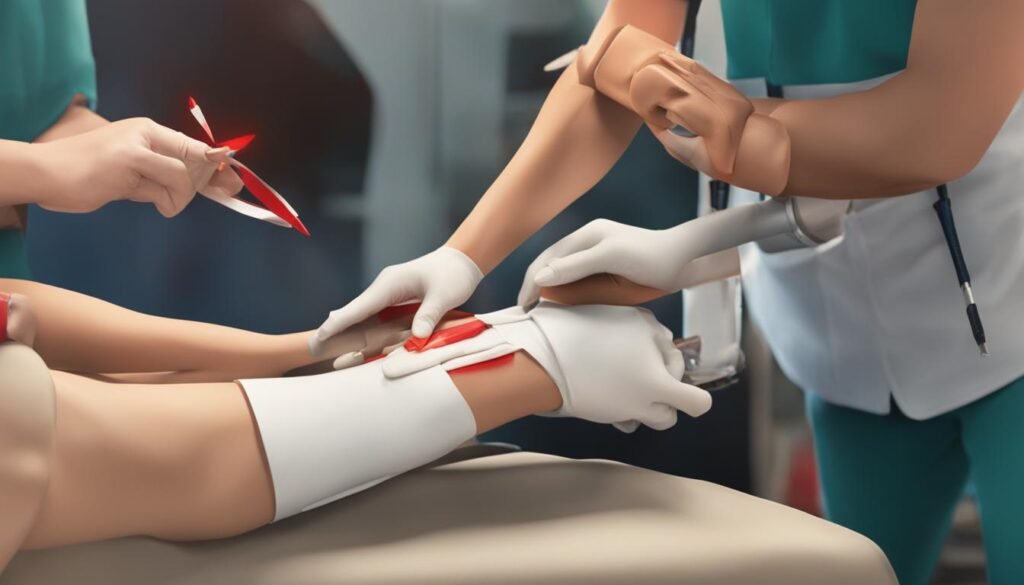As temperatures rise, it’s important to be aware of the signs and symptoms of heat exhaustion and understand the necessary steps to take in order to prevent it from escalating into a more serious condition like heatstroke. Heat exhaustion is a heat-related syndrome that can range from mild to potentially life-threatening.
Symptoms of heat exhaustion include cool and moist skin, heavy sweating, faintness, dizziness, fatigue, rapid pulse, low blood pressure, muscle cramps, nausea or vomiting, headache, extreme thirst, mild confusion, and decreased urine output. If you notice any of these symptoms in yourself or someone else, it’s crucial to take immediate action to provide first aid and prevent further complications.
In the following sections, I will guide you through the recognition of heat exhaustion symptoms, provide immediate first aid measures, offer prevention tips, explain the dangers of heatstroke, discuss heat cramps, and share expert advice on preventing heat-related illnesses. By being well-informed and prepared, you can effectively manage heat exhaustion and keep yourself and others safe in hot weather conditions.
Key Takeaways:
- Heat exhaustion is a heat-related syndrome that can range from mild to potentially life-threatening.
- Symptoms of heat exhaustion include cool and moist skin, heavy sweating, faintness, dizziness, fatigue, and more.
- If you suspect heat exhaustion, take immediate action to prevent it from escalating to heatstroke.
- Recognizing heat exhaustion symptoms is crucial for providing prompt first aid.
- Immediate first aid measures for heat exhaustion involve moving the person to a cooler area, providing fluids, and cooling the body.
Recognizing Heat Exhaustion Symptoms
Recognizing the signs and symptoms of heat exhaustion is crucial for providing prompt first aid and preventing further complications. When exposed to high temperatures and excessive heat, individuals may experience the following symptoms:
- Cool and moist skin with goosebumps when in the heat
- Heavy sweating
- Faintness and dizziness
- Fatigue and weakness
- Rapid and weak pulse
- Low blood pressure
- Muscle cramps
- Nausea or vomiting
- Headache
- Extreme thirst
- Mild confusion
- Decreased urine output
It’s important to remain vigilant and recognize these symptoms, as heat exhaustion can progress to heatstroke if left untreated.
Quote:
“Identifying the signs of heat exhaustion is crucial for providing timely assistance and preventing heat-related complications.” – Dr. Emily Smith, Board-certified Physician
By being aware of the signs and symptoms listed above, individuals can take immediate action to alleviate heat exhaustion and seek appropriate medical attention if necessary. Remember, recognizing the symptoms is the first step in effectively managing and preventing heat-related illnesses.
Immediate First Aid Measures for Heat Exhaustion
If you suspect someone is experiencing heat exhaustion, it’s crucial to take immediate first aid measures to provide relief and prevent further complications. Follow these steps:
- Move to a Shady or Air-Conditioned Area: Get the person out of the heat and into a cool environment.
- Lie Down and Elevate Legs: Have the person lie down and elevate their legs slightly to improve blood flow.
- Remove Tight or Heavy Clothing: Help the person remove any tight or heavy clothing that may restrict ventilation and cooling.
- Provide Chilled Fluids: Offer the person chilled water, electrolyte sports drinks, or other non-caffeinated beverages to sip and replenish fluids.
- Cool with Water and Fan: Cool the person by spraying or sponging them with cool water and using a fan to increase evaporation.
- Monitor Symptoms: Stay with the person and monitor their symptoms closely. Watch for any worsening of symptoms or lack of improvement.
If the person’s condition does not improve with first aid measures or if their symptoms worsen, seek immediate medical attention for further evaluation and treatment.
Prevention Tips for Heat Exhaustion
Preventing heat exhaustion is essential to safeguarding against its potentially dangerous consequences. By following these simple tips, you can minimize the risk of heat exhaustion:
- Stay hydrated: Drink plenty of fluids, especially water, throughout the day to stay properly hydrated and combat dehydration.
- Avoid excessive physical activity: Be mindful of your physical exertion levels, particularly in hot and humid conditions where the risk of heat exhaustion is greatest.
- Take frequent breaks: Make it a habit to rest in cool or shaded areas, allowing your body to cool down and recover from heat exposure.
- Wear appropriate clothing: Choose lightweight, light-colored, and loose-fitting clothing to promote ventilation and minimize heat absorption.
- Protect your skin: Apply sunscreen generously to shield your skin from the sun’s harmful rays, reducing the risk of sunburn and overheating.
- Avoid dehydration-inducing drinks: Refrain from consuming alcoholic and caffeinated beverages, as they can contribute to dehydration.
- Stay informed: Stay up to date with the weather forecast, and plan your activities accordingly to avoid extended exposure to high temperatures.
By incorporating these preventative measures into your daily routine, you can significantly reduce the likelihood of experiencing heat exhaustion and its associated risks.
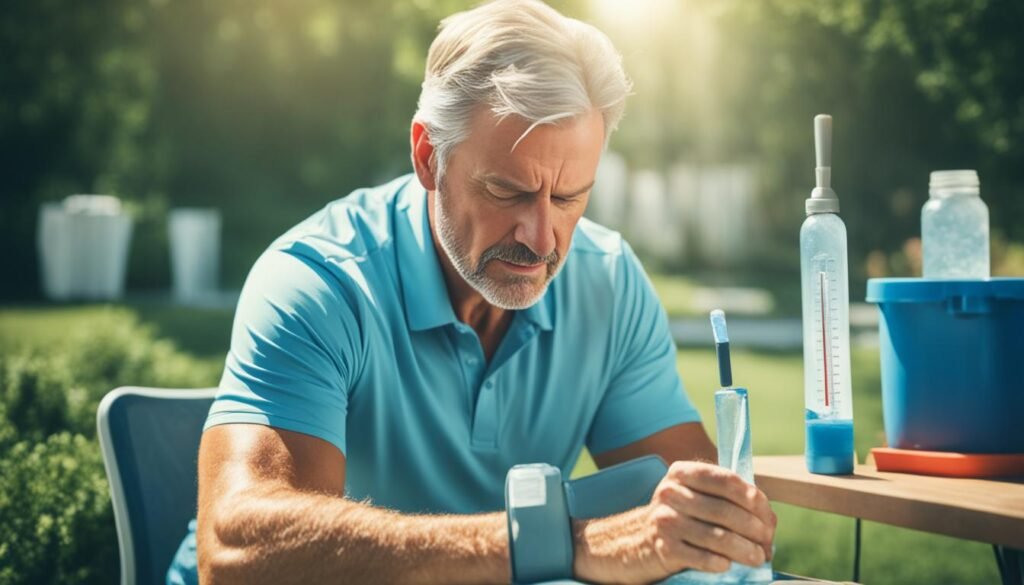
“Preventing heat exhaustion is essential to safeguarding against its potentially dangerous consequences.”
Understanding Heat Stroke and its Dangers
Heat exhaustion, if left untreated, can escalate into a life-threatening condition known as heatstroke. Heatstroke occurs when the body’s core temperature reaches 104 degrees Fahrenheit (40 degrees Celsius) or higher. It is a medical emergency that requires immediate medical attention and should not be managed with first aid alone.
Symptoms of heatstroke include:
- Throbbing headache
- Confusion
- Nausea
- Dizziness
- High body temperature
- Hot and dry or damp skin
- Rapid and strong pulse
- Fainting
- Loss of consciousness
If you suspect someone is experiencing heatstroke, it is important to act quickly. Call 911 or the local emergency number immediately. While waiting for medical help to arrive, move the person to a cool, shaded area and remove any excess clothing. Apply cool water or ice packs to their body to help lower their temperature. Do not offer them fluids to drink, as they may be unable to swallow or at risk of choking. Medical professionals should provide the appropriate treatment for heatstroke.
Image:
Recognizing Heat Cramps
Heat cramps are often the first sign of heat-related illness and should not be ignored. If left untreated, heat cramps can progress to more severe conditions like heat exhaustion or heatstroke. It’s crucial to recognize the symptoms of heat cramps in order to take appropriate action and prevent further complications.
Symptoms of heat cramps include:
- Painful muscle cramps and spasms, usually in the legs and abdomen
- Heavy sweating
If you or someone you know experiences these symptoms, it’s essential to provide immediate first aid to provide relief and prevent the condition from worsening.
First aid for heat cramps involves:
- Applying firm pressure to the cramping muscles
- Gently massaging the affected area to relieve spasms
- Offering sips of water, unless the person complains of nausea
The image above visually represents the discomfort and pain associated with heat cramps, highlighting the importance of recognizing and addressing this heat-related condition promptly.
By recognizing the signs of heat cramps and providing first aid, you can help alleviate symptoms and prevent the progression to more serious heat-related illnesses. Remember to stay hydrated and take breaks in a cool environment to prevent heat cramps and other heat-related conditions.
First Aid for Heat Cramps and Heat Exhaustion
When it comes to heat-related illnesses, knowing how to provide first aid can make a significant difference in preventing further complications and ensuring the well-being of those affected. In this section, I will outline the essential first aid measures for both heat cramps and heat exhaustion.
First Aid for Heat Cramps
Heat cramps are characterized by painful muscle cramps and spasms, typically occurring in the legs and abdomen, accompanied by heavy sweating. If someone experiences heat cramps, here’s what you can do:
- Apply firm pressure to the cramping muscles or gently massage them to relieve spasms.
- Offer the person sips of water, unless they complain of nausea.
If heat cramps persist for longer than one hour or if the person’s symptoms worsen, it is crucial to seek immediate medical attention for further evaluation and treatment.
First Aid for Heat Exhaustion
Heat exhaustion is a more serious condition that requires prompt intervention to prevent it from progressing to heatstroke. If you suspect someone is experiencing heat exhaustion, here are the first aid measures to take:
- Move the person to a cooler environment, preferably an air-conditioned area or a shaded spot.
- Loosen their clothing to promote better heat dissipation.
- Apply cool, wet cloths to the person’s forehead, neck, armpits, and groin area to help lower their body temperature. Alternatively, they can sit in a cool bath.
- Offer them sips of water or a sports drink to rehydrate. Avoid caffeinated or alcoholic beverages.
- Monitor the person closely for any changes in their condition.
If symptoms persist or worsen, such as repeated vomiting or worsening confusion, it is crucial to seek immediate medical attention. Heat exhaustion can have severe consequences if not treated promptly.
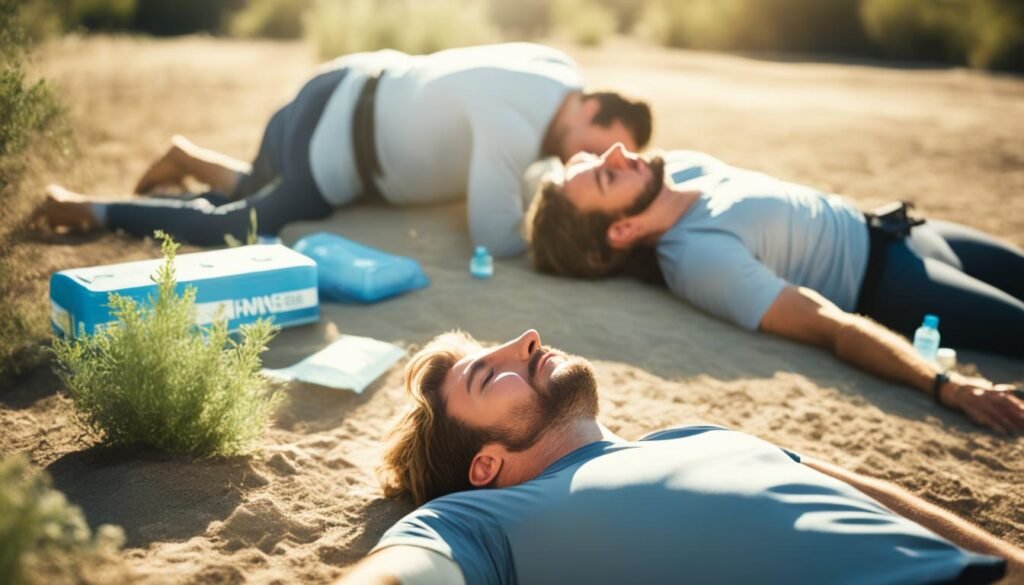
Preventing Dehydration and Heat-Related Illness
Staying properly hydrated is essential for preventing dehydration and heat-related illnesses like heat exhaustion. To keep your body hydrated, it’s important to drink fluids throughout the day, especially when engaging in physical activity or spending time in hot and humid environments. While water is the best choice for hydration, you can also get fluids from other sources such as fruits and vegetables, which contain high water content.
Avoid excessive intake of caffeine and sugary beverages, as they can contribute to dehydration. Caffeine acts as a diuretic, increasing urine production and potentially leading to fluid loss in the body. Similarly, sugary beverages can disrupt the body’s fluid balance and may not adequately replenish electrolytes lost through sweating.
By prioritizing hydration and maintaining a consistent intake of fluids, you can help prevent dehydration and reduce the risk of heat-related illnesses. Remember, prevention is always better than cure when it comes to your health.
| Benefit | Description |
|---|---|
| Regulates body temperature | Hydration helps the body maintain a stable internal temperature, allowing it to cool down effectively and avoid overheating. |
| Supports physical performance | Adequate hydration is essential for optimal physical performance, helping to maintain endurance, strength, and coordination. |
| Aids digestion and nutrient absorption | Proper hydration supports the digestive process, allowing for the efficient breakdown and absorption of nutrients from food. |
| Promotes cardiovascular health | Being well-hydrated supports healthy blood flow and circulation, reducing the risk of cardiovascular issues. |
| Enhances cognitive function | Dehydration can impair brain function, affecting focus, concentration, and overall cognitive performance. |
When it comes to maintaining hydration, remember to listen to your body’s thirst cues and drink fluids even before you feel thirsty. Additionally, during periods of intense physical activity or exposure to heat, aim to drink water at regular intervals to replenish fluids lost through sweating.
“A well-hydrated body is better equipped to manage the demands of heat and physical exertion, reducing the risk of heat-related illnesses.”
Importance of Hydration and Its Effects on the Body
Proper hydration plays a vital role in maintaining the body’s temperature regulation and overall well-being. When the body becomes dehydrated, it loses its ability to effectively cool itself, which can significantly increase the risk of heat-related illnesses, such as heat exhaustion.
Dehydration can lead to a range of symptoms that indicate an imbalance in the body’s fluid levels. These symptoms include persistent thirst, dry mouth, fatigue, dizziness, dark-colored urine, and decreased urine output. It’s important to recognize these signs as they indicate a need for immediate hydration.
By prioritizing hydration, individuals can replenish the body’s water and electrolyte levels, ensuring optimal bodily functions. Drinking enough fluids, especially water, throughout the day is essential for preventing dehydration and maintaining overall health.
“Proper hydration is the key to preventing heat-related illnesses and ensuring the body functions at its best.”
Aside from preventing heat-related illnesses, staying hydrated offers numerous benefits to the body. It helps transport essential nutrients to cells, supports digestion, regulates body temperature, lubricates joints, and aids in cognitive function.
To stay properly hydrated, it’s recommended to drink water regularly throughout the day. Avoid excessive consumption of caffeinated and sugary beverages, as they can contribute to dehydration. Additionally, consuming fruits and vegetables that have high water content can supplement fluid intake and contribute to overall hydration.
Promote Optimal Hydration with These Tips:
- Carry a water bottle with you at all times to remind yourself to drink frequently.
- Set reminders or use hydration tracking apps to ensure you’re drinking enough water throughout the day.
- Drink water before, during, and after physical activity to replenish lost fluids.
- Avoid waiting until you’re thirsty to drink water, as thirst is a sign of dehydration.
- Monitor the color of your urine. Pale yellow urine generally indicates adequate hydration, while dark-colored urine may suggest dehydration.
By recognizing the importance of hydration and making it a priority, individuals can safeguard their health, promote optimal bodily functions, and reduce the risk of heat-related illnesses like heat exhaustion.
Expert Advice on Preventing Heat-Related Illness
When it comes to preventing heat-related illnesses, expert advice can make all the difference. These professionals recommend taking certain precautions, especially during hot and humid weather, to keep yourself safe and healthy. By following their guidance, you can minimize the risk of heat-related illnesses and enjoy the summer season to the fullest.
Stay Hydrated
One of the most important pieces of advice is to stay hydrated. Drink plenty of water throughout the day, even if you don’t feel thirsty. Dehydration can quickly set in during hot weather, leading to heat exhaustion or heatstroke. Carry a water bottle with you wherever you go and make it a habit to take regular sips.
Avoid Excessive Physical Activity
During extreme heat, it’s essential to avoid excessive physical activity. The combination of high temperatures and intense exercise can quickly overwhelm your body, increasing the risk of heat-related illnesses. Instead, schedule your outdoor activities for cooler times of the day and modify your exercise routine accordingly.
Seek Shade and Wear Appropriate Clothing
To prevent overheating, seek shade whenever possible. Stay under trees, awnings, or use umbrellas to protect yourself from direct sunlight. Additionally, wearing appropriate clothing can make a significant difference. Opt for lightweight, light-colored, and loose-fitting clothes that allow your body to breathe and cool down naturally.
Use Sunscreen and Monitor the Weather
Protecting your skin from the sun’s harmful rays is vital for preventing heat-related illnesses. Always use sunscreen with a high SPF and apply it generously before going outside. Additionally, staying informed about the weather forecast can help you plan your activities better. If extremely high temperatures or heat advisories are expected, consider rescheduling or avoiding outdoor activities altogether.
| Expert Advice on Preventing Heat-Related Illness | |
|---|---|
| Stay hydrated | Drink plenty of water throughout the day to avoid dehydration. |
| Avoid excessive physical activity | Modify your exercise routine to avoid exertion in extreme heat. |
| Seek shade and wear appropriate clothing | Stay under shade and wear loose, light-colored clothing. |
| Use sunscreen and monitor the weather | Protect your skin and stay informed about heat advisories. |
Remember, the advice provided by experts is meant to serve as a general guideline. If you have specific concerns or health conditions that may increase your vulnerability to heat-related illnesses, it’s essential to consult with a healthcare professional. Prioritizing your well-being and taking the necessary precautions will ensure that you can enjoy the summer safely.
Conclusion
Heat exhaustion is a serious condition that requires immediate attention to prevent it from progressing into heatstroke, which can be life-threatening. Recognizing the symptoms of heat exhaustion, such as heavy sweating, dizziness, and fatigue, is crucial for timely intervention. By following first aid measures such as moving the person to a cooler place, providing fluids, and cooling the body, symptoms can be alleviated, and further complications can be prevented.
One of the key ways to prevent heat-related illnesses like heat exhaustion is to prioritize hydration and prevent dehydration. Staying properly hydrated, especially in hot and humid conditions, is essential. Drinking plenty of fluids, particularly water, throughout the day is important for replenishing the body’s water and electrolyte levels. By avoiding excessive physical activity in extreme heat, seeking shade, wearing appropriate clothing, and using sunscreen, individuals can minimize their risk of heat-related illnesses.
To ensure safety, it is important to follow the tips and recommendations provided by medical experts. By taking precautions, such as staying hydrated, avoiding excessive heat exposure, and monitoring the weather forecast, individuals can protect themselves and others from the dangers of heat exhaustion and heatstroke, effectively preventing heat-related illnesses. So remember, be vigilant, take immediate action when needed, and prioritize heat exhaustion first aid for a safe and enjoyable summer.
FAQ
How can I recognize the symptoms of heat exhaustion?
The symptoms of heat exhaustion include cool and moist skin, heavy sweating, faintness, dizziness, fatigue, rapid pulse, low blood pressure, muscle cramps, nausea or vomiting, headache, extreme thirst, mild confusion, and decreased urine output.
What should I do if I suspect someone is experiencing heat exhaustion?
If you suspect someone is experiencing heat exhaustion, it’s important to take immediate first aid measures. Move the person out of the heat and into a shady or air-conditioned area, have them lie down with their legs elevated slightly, remove tight or heavy clothing, provide chilled water or electrolyte sports drinks to sip, cool the person with water and a fan, and monitor them closely. Seek medical attention if their symptoms worsen or don’t improve.
What are some ways to prevent heat exhaustion?
To prevent heat exhaustion, you can stay hydrated by drinking plenty of fluids, avoid excessive physical activity in hot and humid conditions, take frequent breaks in cool or shaded areas, wear lightweight and loose-fitting clothing, use sunscreen, avoid alcoholic and caffeinated beverages, and be aware of the weather forecast.
What is the difference between heat exhaustion and heatstroke?
Heat exhaustion is a heat-related syndrome characterized by excessive sweating and dehydration, while heatstroke is a life-threatening condition where the body’s core temperature reaches 104 degrees Fahrenheit or higher. Heatstroke requires immediate medical attention, whereas heat exhaustion can often be managed with first aid measures.
What are the symptoms of heat cramps?
Heat cramps are characterized by painful muscle cramps and spasms, usually in the legs and abdomen, accompanied by heavy sweating.
How should I provide first aid for heat cramps and heat exhaustion?
For heat cramps, apply firm pressure to the cramping muscles or gently massage them to relieve spasms. Sips of water can be given unless the person complains of nausea. For heat exhaustion, move the person to a cooler environment, loosen their clothing, apply cool, wet cloths or have them sit in a cool bath, offer sips of water, and seek immediate medical attention if vomiting occurs more than once or symptoms worsen.
How can I prevent dehydration and heat-related illnesses?
To prevent dehydration and heat-related illnesses, drink plenty of fluids throughout the day, especially water, avoid excessive intake of caffeine and sugary beverages, and consume fruits and vegetables that contribute to hydration. Take precautions such as staying in shaded areas and monitoring the weather forecast.
Why is hydration important and what are the effects of dehydration?
Hydration is crucial for maintaining the body’s temperature regulation and overall well-being. Dehydration can lead to symptoms such as thirst, dry mouth, fatigue, dizziness, dark-colored urine, and decreased urine output.
What advice do experts give for preventing heat-related illnesses?
Experts recommend staying hydrated, avoiding excessive physical activity in extreme heat, seeking shade, wearing appropriate clothing, using sunscreen, and monitoring the weather forecast. It’s important to seek medical advice to address individual concerns.
Is heat exhaustion a serious condition and how can it be relieved?
Heat exhaustion is a serious condition that can lead to heatstroke if not addressed promptly. To relieve heat exhaustion, it’s important to recognize the symptoms, provide immediate first aid measures, and seek medical attention if necessary.

